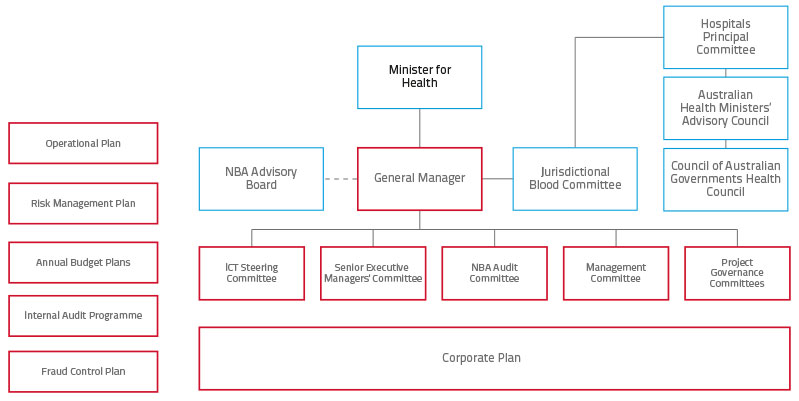Governance Structure

FIGURE 3.1 NBA Governance structure
Governance Committees
An overview of the NBA Governance structure is shown in Figure 3.1.
Five governance committees assist the NBA General Manager to plan and manage corporate governance, outcome delivery, strategic projects and stakeholder interests:
- The Senior Executive Managers’ Committee is the NBA’s primary policy and process decision-making body and comprises the senior executive management team. The committee meets once a week and supports the General Manager in operational matters relating to outcome delivery, risk management, stakeholder management, ethics and governance of the NBA.
- The Management Committee is a wider group of managers made up of direct reports to the General Manager and Executive Level 2 Directors and meets once a month to discuss and progress operational and performance issues.
- The ICT Steering Committee, chaired by the NBA General Manager, provides strategic direction and oversight of the NBA’s information, communications, technology and knowledge management activities. Membership of the committee includes Senior Executive Management, the Chief Finance Officer and the Deputy Chief Information Officer.
- The Project Governance Committees, chaired by the NBA General Manager, provide governance oversight of major strategic projects of material significance. The terms of reference and membership of each committee is specific to the project. Project Governance Committees operated in 2013-14 for the following projects:
- MyABDR Development and Implementation
- BloodNet/ABDR Development and Enhancement
- Immunoglobulin Governance Project
- Immunoglobulin Governance Database
- The Audit Committee provides independent assurance and advice to the General Manager on strategies to enhance the organisation’s governance control and risk management framework, the planning and conduct of the NBA internal audit programme and support financial and legislative compliance. The Committee met six times in 2013-14. Its membership in 2013-14 was as follows:
- Ms Jennifer Morison (Chair) (retired 11 October 2013)
- Mr Ken Barker (Member until 11 October 2013; Chair from 12 October 2013)
- Mr Mick Roche
- Mr Paul Bedbrook (Member from 25 November 2013)
- Representatives from the ANAO and the NBA internal auditors (KPMG) also attend meetings as observers for most matters.
NBA Management
During 2013-14 the NBA senior executive management team comprised the following:
- General Manager - Mr Leigh McJames
- Deputy General Manager and General Counsel - Mr Michael Stone
- Executive Director Fresh Blood, Data & Clinical Development - Ms Sandra Cochrane
- Executive Director Health Provider Engagement and Chief Information Officer - Mr Peter O’Halloran
As at 30 June 2014, the NBA comprised the following 13 teams/business streams:
- Blood Sector Clinical Development
- Secretariat and Communications
- Data and Information Analysis
- Finance and Risk Management
- Health Provider Engagement
- Horizon Scanning
- Human Resources and Corporate Support
- iBlood Applications Development
- iBlood Infrastructure
- Ig Governance
- Legal Services
- Supply Management – Fresh Blood
- Supply Management - Plasma and Recombinant Products
Internal Audit
The NBA’s internal audit programme, guided by the Audit Committee, plays a key part in risk mitigation. The NBA has a comprehensive risk management framework that includes a living risk register and an annual bottom-up hierarchical risk review process. The Audit Committee reviews the risk register on an annual basis as a key input in developing the internal audit programme.
KPMG conducted a range of audits and reviews in line with the work programme developed in conjunction with the Audit Committee. The 2013-14 work programme encompassed reviews on risk management, governance arrangements, imported plasma and recombinant products procurement, credit cards and protective security policy framework.
The Audit Committee continued to monitor the implementation of internal audit report recommendations through status reports.
